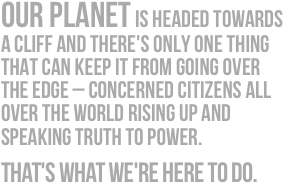-by Sarah
After lunch I walked by the World Meteorological Institute’s (WMO) booth and decided to try to get a better idea of how people actually monitor things like atmospheric temperature, sea surface temperature, weather, etc. and how that information is used.
After speaking to a WMO representative, I have gleaned the following info, which I think is interesting.
There are several satellites from which come a lot of the data that the WMO uses. These satellites have been around for approximately twenty years- not a hugely long time, highlighting that the science of climate is a relatively knew thing- at least in terms of advanced technology. (And technology will probably continue to change, so what we have now may become as outdated as measurements from regular old thermometers or people’s journal entries saying that a month was particularly hot or a flood happened). There are also several ground stations that are a part of, or at least contribute information to, the WMO’s Global Atmosphere Watch (GAW). A glance at the map of the distribution of these stations reveals that a very very high percentage of them are concentrated in the US and Europe, which says something not only about why developing countries have a harder time getting information (the woman I spoke to also pointed out the fact that a lot of computer power is needed to process the information and developing countries just don’t have that) but about how much truly global data there is. The information that is gathered and synthesized is used to predict weather and in early warning systems for natural disasters. However, the same gap between developed and developing countries applies to communications systems, which affects how useful early warnings are.
I asked the woman I spoke with how the WMO makes predictions when the earth is so dynamic and different factors in climate are always changing. She said that they look at historical data- at least 30 years back, she said- and use that in combination with current observations to see what has happened and make a prediction based on that. I asked how accurate that was, and she said about 75% of the WMO’s predictions actually come to fruition. This seems relatively high to me, and, as she pointed out, “it is enough to base a decision on, such as where to spend money.” I can see the logic in this; absolute certainty, it seems to me, is merely a concept and will never exist. But it’s useful enough in a country like Kenya, where drought has devastated much of the country, to have an early warning in order to be able to prepare and help its people. However, there are obstacles (such as getting an early warning, disseminating that information to citizens, and actually taking action to help people survive it) that depend on the capacity, infrastructure, and resources of a nation in the use of the information and carrying out of a plan.


